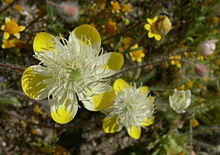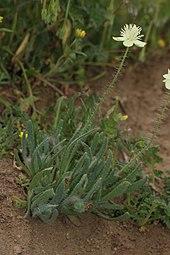| Platystemon | |
|---|---|
 | |
| Scientific classification | |
| Kingdom: | Plantae |
| Clade: | Tracheophytes |
| Clade: | Angiosperms |
| Clade: | Eudicots |
| Order: | Ranunculales |
| Family: | Papaveraceae |
| Subfamily: | Papaveroideae |
| Tribe: | Platystemoneae |
| Genus: | Platystemon Benth. |
| Species: | P. californicus |
| Binomial name | |
| Platystemon californicus Benth. | |
Platystemon is a monotypic genus of flowering plants in the poppy family containing the single species Platystemon californicus, which is known by the common name creamcups.[1] It is native to Oregon, California, Arizona, Utah and Baja California, and is found in open grasslands and sandy soils below 6,000 feet (1,800 m) elevation.[2][3]

Description
Platystemon californicus is a variable plant taking such a wide range of forms it has been split, reorganized, and redescribed as up to 57 different species. Its form often varies according to geography and habitat conditions. Coastal forms may be hairless and a bit succulent, while semidesert individuals can be squat, hairy plants. Some authors describe separate varieties, which are ecotypes adapted to specific, often very limited, habitat types.[4]
The annual herb is usually at least a bit hairy, sometimes quite woolly. The stem is upright to decumbent and 3 to 30 centimeters long. The leaves are oppositely arranged or whorled about the stem. They are widely linear and smooth-edged with rounded or pointed tips. They are 1 to 9 centimeters long. The inflorescence is a single flower growing from a leaf axil or the tip of the stem. It is borne on a peduncle 3 to 26 centimeters long with three hairy sepals.[2] The flower usually has six petals, but a large flower can have more. The petals vary in size, shape, and color. They measure 6 to 19 millimeters long and have rounded or pointed tips.[4] There are five basic color patterns: solid white, solid yellow, and a white petal with a yellow tip or yellow base or both.[5] The all-yellow petals are less common. The petals may age reddish. The center of the flower is filled with several whorls of stamens with thickened ends. The fruit is a capsule up to 1.6 centimeters long which is divided into many sections containing shiny black seeds.[4]
The flowers are partly wind-pollinated and partly pollinated by solitary bees.[6]
References
- ^ "Platystemon californicus". Natural Resources Conservation Service PLANTS Database. USDA. Retrieved 7 October 2015.
- ^ a b "Platystemon californicus". in Jepson Flora Project (eds.) Jepson eFlora. Jepson Herbarium; University of California, Berkeley. 2018. Retrieved 2018-07-06.
- ^ Sullivan, Steven. K. (2018). "Platystemon californicus". Wildflower Search. Retrieved 2018-07-06.
- ^ a b c d Platystemon californicus. Flora of North America.
- ^ Hannan, G. L. (1982). Correlation of morphological variation in Platystemon californicus (Papaveraceae) with flower color and geography. Systematic Botany 7(1) 35-47.
- ^ Hannan, G. L. (1981). Flower color polymorphism and pollination biology of Platystemon californicus Benth.(Papaveraceae). American Journal of Botany 68(2) 233-43.
External links
 Media related to Platystemon californicus at Wikimedia Commons
Media related to Platystemon californicus at Wikimedia Commons- Platystemon californicus. CalPhotos.
